|
Equities advanced globally last week amid volatile trading. Geopolitical concerns in both Asia and Europe hit investor sentiment as it veered from negative to positive and back again. In Europe, sanctions against Russia for its support of Syria caused ructions there. But investors have begun to shrug off geopolitical concerns and have turned their focus instead on a results season expected to support equity markets.
| |
|
2017 |
2018 |
% Change |
|
Index |
Dec 29 |
April 6 |
April 13 |
Week |
2018 |
| Asia/Pacific |
|
|
|
|
|
|
| Australia |
All Ordinaries |
6167.3 |
5886.9 |
5924.67 |
0.6% |
-3.9% |
| Japan |
Nikkei 225 |
22764.9 |
21567.5 |
21778.74 |
1.0% |
-4.3% |
|
Topix |
1817.56 |
1719.30 |
1729.36 |
0.6% |
-4.9% |
| Hong Kong |
Hang Seng |
29919.2 |
29844.9 |
30808.38 |
3.2% |
3.0% |
| S. Korea |
Kospi |
2467.5 |
2429.6 |
2455.07 |
1.0% |
-0.5% |
| Singapore |
STI |
3402.9 |
3442.5 |
3501.30 |
1.7% |
2.9% |
| China |
Shanghai Composite |
3307.2 |
3131.1 |
3159.05 |
0.9% |
-4.5% |
|
|
|
|
|
|
|
| India |
Sensex 30 |
34056.8 |
33626.97 |
34192.65 |
1.7% |
0.4% |
| Indonesia |
Jakarta Composite |
6355.7 |
6175.1 |
6270.33 |
1.5% |
-1.3% |
| Malaysia |
KLCI |
1796.8 |
1837.0 |
1868.47 |
1.7% |
4.0% |
| Philippines |
PSEi |
8558.4 |
7945.7 |
7899.98 |
-0.6% |
-7.7% |
| Taiwan |
Taiex |
10642.9 |
10821.5 |
10965.39 |
1.3% |
3.0% |
| Thailand |
SET |
1753.7 |
1739.9 |
1767.17 |
1.6% |
0.8% |
|
|
|
|
|
|
|
| Europe |
|
|
|
|
|
|
| UK |
FTSE 100 |
7687.8 |
7183.6 |
7264.56 |
1.1% |
-5.5% |
| France |
CAC |
5312.6 |
5258.2 |
5315.02 |
1.1% |
0.0% |
| Germany |
XETRA DAX |
12917.6 |
12241.3 |
12442.40 |
1.6% |
-3.7% |
| Italy |
FTSE MIB |
21853.3 |
22929.9 |
23330.32 |
1.7% |
6.8% |
| Spain |
IBEX 35 |
10043.9 |
9682.8 |
9767.30 |
0.9% |
-2.8% |
| Sweden |
OMX Stockholm 30 |
1576.9 |
1511.4 |
1526.66 |
1.0% |
-3.2% |
| Switzerland |
SMI |
9381.9 |
8671.0 |
8776.17 |
1.2% |
-6.5% |
|
|
|
|
|
|
|
| North America |
|
|
|
|
|
|
| United States |
Dow |
24719.2 |
23932.76 |
24360.14 |
1.8% |
-1.5% |
|
NASDAQ |
6903.4 |
6915.1 |
7106.65 |
2.8% |
2.9% |
|
S&P 500 |
2673.6 |
2604.5 |
2656.30 |
2.0% |
-0.6% |
| Canada |
S&P/TSX Comp. |
16209.1 |
15207.4 |
15273.97 |
0.4% |
-5.8% |
| Mexico |
Bolsa |
49354.4 |
46124.9 |
48768.30 |
1.8% |
-1.2% |
 European equities advanced across the board in spite of geopolitical worries — investors were looking forward to the start of earnings season. The FTSE and CAC were up 1.1 percent, the DAX added 1.6 percent and the SMI advanced 1.2 percent. European equity markets remained muted at the end of a week dominated by geopolitics and concerns over global trade. The geopolitical tensions were focused on Syria after U.S. President Donald Trump threatened missile strikes in response to a suspected poison gas attack in Syria and prompting worries over a confrontation with Russia, Syria’s main ally. European equities advanced across the board in spite of geopolitical worries — investors were looking forward to the start of earnings season. The FTSE and CAC were up 1.1 percent, the DAX added 1.6 percent and the SMI advanced 1.2 percent. European equity markets remained muted at the end of a week dominated by geopolitics and concerns over global trade. The geopolitical tensions were focused on Syria after U.S. President Donald Trump threatened missile strikes in response to a suspected poison gas attack in Syria and prompting worries over a confrontation with Russia, Syria’s main ally.
The European Central Bank published minutes of its March 8 Governing Council meeting. At that time, the Governing Council left its policy unchanged. The ECB left key interest rates and its asset purchase program (APP) unchanged. The benchmark refi rate remained at zero percent while the rates on the deposit and marginal lending facilities stayed at minus 0.40 percent and 0.30 percent respectively. Net QE asset purchases similarly stay at €30 billion a month. The discussions contained no real surprises and confirmed a general, but not unanimous, preparedness to keep policy on hold. Domestic and global economic uncertainties together with still muted underlying inflation pressures called for caution and underlined the need to maintain a stance built on patience and persistence. However, increasing confidence in the Eurozone's economic recovery and, in turn, the inflation outlook, was seen as justifying the removal of the longstanding easing bias. Even then it was noted that the move should not be misunderstood as restricting the Governing Council's capacity to react to shocks and contingencies, if necessary.
According to National Institute of Economic and Social Research (NIESR), the heavy snow in late February and early March is likely to have caused British economic growth to halve in the first three months of the year to 0.2 percent. Official figures showed the economy grew 0.4 percent in the last three months of 2017. First quarter gross domestic product data will be released on April 27. The main reason for the weakness was severe weather in March which is likely to have disrupted activity in all major sectors. Past experience of snowy weather in 2010 also suggested early estimates of GDP were likely to be revised more than normal.
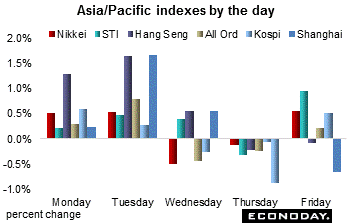 Equities rallied from a week ago with only shares in the Philippines declining for the week. Shares were mixed at week’s end as investors waited for key earnings reports from JPMorgan Chase, Citigroup and Wells Fargo to be released later in the global market day. China’s March merchandise trade data proved to be a mixed bag. The trade balance turned negative from a year ago for the first time since February 2017. Equities rallied from a week ago with only shares in the Philippines declining for the week. Shares were mixed at week’s end as investors waited for key earnings reports from JPMorgan Chase, Citigroup and Wells Fargo to be released later in the global market day. China’s March merchandise trade data proved to be a mixed bag. The trade balance turned negative from a year ago for the first time since February 2017.
Equities fluctuated alternating with geopolitical tensions. President Trump surprised by saying that U.S. would rejoin the controversial Trans Pacific Partnership trade pact if the deal were substantially better than the one offered to former President Barack Obama. However, his words were met with skepticism amongst the pact’s members. The STI, Sensex and KLCI all gained 1.7 percent on the week. Only the PSEi declined 0.6 percent.
Equities rallied in Singapore after first quarter gross domestic product climbed 4.3 percent when compared with the same quarter a year ago after increasing 3.6 percent in the fourth quarter. The data were based largely on January and February data. Much of that growth came from the manufacturing sector, which expanded 10.1 percent on the year after slowing to 4.8 percent in the fourth quarter. Services sector growth was also up from the December quarter.
President Xi Jinping promised Tuesday to open the economy further and lower import tariffs on products like cars, in a speech seen as an attempt to defuse the increasingly bitter trade dispute with the United States and possibly open the way for the start of negotiations after both sides threatened tit-for-tat tariffs.
Bank of Japan Governor Haruhiko Kuroda said as he began his second term that the BoJ would eventually need to consider how to normalize its ultra-easy monetary policy. But he reiterated that it was too early to debate specific means to whittle down stimulus with inflation distant from the BoJ's 2.0 percent target. "I think the process of any shift (from easy policy) would be cautious and gradual, as with U.S. and European central banks," Kuroda told a news conference.
 The U.S. dollar retreated against the euro, pound sterling and the Canadian and Australian dollars. The U.S. currency advanced against the safe haven currencies yen and Swiss franc. Sterling rose to a new 10-week high against the dollar Friday and pulled itself out of a six-month trading range against the euro. But cautious minutes from the European Central Bank Thursday and firm expectations of a rate increase from the Bank of England when it meets on May 10, pushed the British currency to an 11-month high. The U.S. dollar retreated against the euro, pound sterling and the Canadian and Australian dollars. The U.S. currency advanced against the safe haven currencies yen and Swiss franc. Sterling rose to a new 10-week high against the dollar Friday and pulled itself out of a six-month trading range against the euro. But cautious minutes from the European Central Bank Thursday and firm expectations of a rate increase from the Bank of England when it meets on May 10, pushed the British currency to an 11-month high.
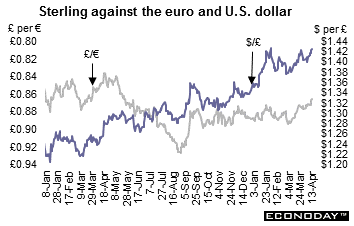 The dollar climbed to a seven-week high against the yen Friday as investors’ focus shifted to anticipated strong U.S. corporate earnings and away from concerns about a possible Western military intervention in Syria. The weakening of the safe haven yen suggested risk appetite had returned after a week dominated by U.S.-China trade tensions and the possibility of a U.S.-led missile strike on Syria. The dollar climbed to a seven-week high against the yen Friday as investors’ focus shifted to anticipated strong U.S. corporate earnings and away from concerns about a possible Western military intervention in Syria. The weakening of the safe haven yen suggested risk appetite had returned after a week dominated by U.S.-China trade tensions and the possibility of a U.S.-led missile strike on Syria.
Hong Kong's monetary authority (HKMA) intervened in the currency market for the first time since 2015 as the currency hit the weaker end of its trading range. The Hong Kong dollar touched the lower end of the central bank's trading band target as the interest rate gap between the U.S. dollar and Hong Kong dollar widened further. Hong Kong pegs its currency to the U.S. dollar and its money market rates mirror those of its U.S. counterparts. The gap between the two has widened since the 2008 financial crisis, as the Federal Reserve began raising interest rates while Hong Kong's markets remained flush with excess cash. The Hong Kong dollar is pegged at 7.8 to the U.S. dollar, but can trade in a range between 7.75 and 7.85. Under the currency peg, the HKMA is obliged to intervene when the Hong Kong dollar hits 7.75 or 7.85 to keep the band intact.
|
|
2017 |
2018 |
% Change |
|
|
Dec 29 |
April 6 |
April 13 |
Week |
2018 |
| U.S. $ per currency |
|
|
|
|
|
|
| Australia |
A$ |
0.779 |
0.768 |
0.777 |
1.2% |
-0.3% |
| New Zealand |
NZ$ |
0.709 |
0.728 |
0.736 |
1.0% |
3.8% |
| Canada |
C$ |
0.796 |
0.783 |
0.793 |
1.3% |
-0.3% |
| Eurozone |
euro (€) |
1.194 |
1.229 |
1.234 |
0.4% |
3.3% |
| UK |
pound sterling (£) |
1.344 |
1.409 |
1.425 |
1.1% |
6.0% |
|
|
|
|
|
|
|
| Currency per U.S. $ |
|
|
|
|
|
|
| China |
yuan |
6.534 |
6.303 |
6.275 |
0.5% |
4.1% |
| Hong Kong |
HK$* |
7.816 |
7.848 |
7.850 |
0.0% |
-0.4% |
| India |
rupee |
64.081 |
64.975 |
65.215 |
-0.4% |
-1.7% |
| Japan |
yen |
112.850 |
106.880 |
107.360 |
-0.4% |
5.1% |
| Malaysia |
ringgit |
4.067 |
3.872 |
3.880 |
-0.2% |
4.8% |
| Singapore |
Singapore $ |
1.338 |
1.316 |
1.312 |
0.3% |
2.0% |
| South Korea |
won |
1070.630 |
1069.620 |
1069.720 |
0.0% |
0.1% |
| Taiwan |
Taiwan $ |
29.775 |
29.271 |
29.307 |
-0.1% |
1.6% |
| Thailand |
baht |
32.696 |
31.280 |
31.146 |
0.4% |
5.0% |
| Switzerland |
Swiss franc |
0.979 |
0.9587 |
0.962 |
-0.4% |
1.7% |
| *Pegged to U.S. dollar |
|
|
|
|
|
|
| Source: Bloomberg |
|
|
|
|
|
|
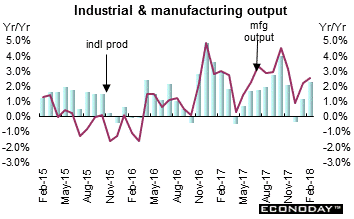 February industrial production edged up 0.1 percent on the month and 2.2 percent from a year ago. The key manufacturing sector declined 0.2 percent — the sector's worst performance since last March. A sharp decline in machinery and equipment (3.9 percent) did most of the damage but there were sizeable decreases in electrical equipment (3.8 percent), textiles and leather (1.9 percent) and wood, paper and printing (1.8 percent). Partial offsets were provided by metal products (1.7 percent) and pharmaceuticals (3.3 percent). Total industrial production was bolstered by a 3.7 percent monthly advance in electricity and gas and a 0.7 percent rise in water supply but dented by a 2.7 percent decline in mining and quarrying. February industrial production edged up 0.1 percent on the month and 2.2 percent from a year ago. The key manufacturing sector declined 0.2 percent — the sector's worst performance since last March. A sharp decline in machinery and equipment (3.9 percent) did most of the damage but there were sizeable decreases in electrical equipment (3.8 percent), textiles and leather (1.9 percent) and wood, paper and printing (1.8 percent). Partial offsets were provided by metal products (1.7 percent) and pharmaceuticals (3.3 percent). Total industrial production was bolstered by a 3.7 percent monthly advance in electricity and gas and a 0.7 percent rise in water supply but dented by a 2.7 percent decline in mining and quarrying.
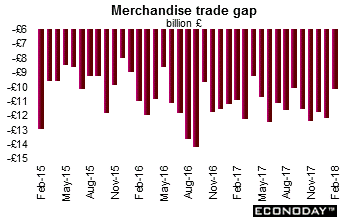 February global deficit on trade in goods narrowed to £10.20 billion and the least red ink since September 2017. However, the headline improvement masked significant contractions in both sides of the balance sheet. Exports fell 2.2 percent on the month while imports tumbled 6.5 percent. The deficit with the rest of the EU was £7.97 billion, down only marginally from £8.19 billion in January. This left the bulk of the decline to trade with the rest of the world where the shortfall dropped from £4.04 billion to £2.24 billion. Around half of the decline in the overall deficit reflected a favorable swing in oil and other erratic items. Excluding this category, the deficit narrowed by only around £1 billion to £10.56 billion. February global deficit on trade in goods narrowed to £10.20 billion and the least red ink since September 2017. However, the headline improvement masked significant contractions in both sides of the balance sheet. Exports fell 2.2 percent on the month while imports tumbled 6.5 percent. The deficit with the rest of the EU was £7.97 billion, down only marginally from £8.19 billion in January. This left the bulk of the decline to trade with the rest of the world where the shortfall dropped from £4.04 billion to £2.24 billion. Around half of the decline in the overall deficit reflected a favorable swing in oil and other erratic items. Excluding this category, the deficit narrowed by only around £1 billion to £10.56 billion.
 February private sector machinery orders (excluding volatile items) rose 2.1 percent on the month after increasing 8.2 percent in January. This series, which excludes orders for ships and those from electric power companies, is considered a proxy for capital expenditures. On the year, orders were up 4.7 percent. Manufacturing orders rose 8.0 percent after rising 9.9 percent on the month in January, while non-manufacturing orders (excluding volatile items) was flat after increasing 4.4 percent previously. February private sector machinery orders (excluding volatile items) rose 2.1 percent on the month after increasing 8.2 percent in January. This series, which excludes orders for ships and those from electric power companies, is considered a proxy for capital expenditures. On the year, orders were up 4.7 percent. Manufacturing orders rose 8.0 percent after rising 9.9 percent on the month in January, while non-manufacturing orders (excluding volatile items) was flat after increasing 4.4 percent previously.
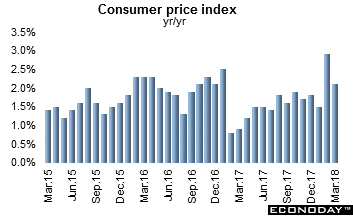 March consumer price index increased 2.1 percent from a year ago, down from 2.9 percent in February. The index fell 1.1 percent on the month after an increase of 1.2 percent previously. Food prices were the main factor driving the decline, increasing by 2.1 percent on the year after an increase of 4.4 percent in February. Non-food price inflation also moderated from 2.5 percent to 2.1 percent, reflecting weaker increases for transport and communication charges. Housing costs were steady at 2.2 percent. Urban inflation fell from 3.0 percent in February to 2.1 percent in March, while rural inflation fell from 2.7 percent to 1.9 percent. March consumer price index increased 2.1 percent from a year ago, down from 2.9 percent in February. The index fell 1.1 percent on the month after an increase of 1.2 percent previously. Food prices were the main factor driving the decline, increasing by 2.1 percent on the year after an increase of 4.4 percent in February. Non-food price inflation also moderated from 2.5 percent to 2.1 percent, reflecting weaker increases for transport and communication charges. Housing costs were steady at 2.2 percent. Urban inflation fell from 3.0 percent in February to 2.1 percent in March, while rural inflation fell from 2.7 percent to 1.9 percent.
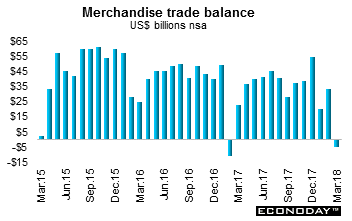 March merchandise trade balance shifted to a deficit of $4.98 billion from February’s surplus of $33.74 billion thanks to distortions caused by the Lunar New Year. Export growth weakened compared with the first two months of the year, as did imports growth. For the three months to March, the trade surplus was well down compared with the equivalent period last year. On a bilateral basis, however, China's trade surplus with the United States in the first three months of the year was above the level recorded for the same time last year. Exports declined 2.7 percent on the year and well down from an increase of 44.5 percent in February. Imports, meanwhile, increased 14.4 percent on the year and up from 6.3 percent in February. In domestic currency terms, China's trade balance shifted from a surplus of CNY224.9 billion in February to a deficit of CNY29.78 billion in March. Exports fell 9.8 percent on the year in yuan terms after increasing by 33.2 percent in February, while imports in yuan terms picked up from a fall of 0.2 percent to an increase of 5.9 percent. When compared with the same month a year ago Chinese exports to the United States were down 5.6 percent from a year ago while imports from the United States were up 3.2 percent. Exports to the European Union were down 7.0 percent while imports were up 10.0 percent. Exports to Japan were down 3.6 percent and imports were up 16.0 percent. March merchandise trade balance shifted to a deficit of $4.98 billion from February’s surplus of $33.74 billion thanks to distortions caused by the Lunar New Year. Export growth weakened compared with the first two months of the year, as did imports growth. For the three months to March, the trade surplus was well down compared with the equivalent period last year. On a bilateral basis, however, China's trade surplus with the United States in the first three months of the year was above the level recorded for the same time last year. Exports declined 2.7 percent on the year and well down from an increase of 44.5 percent in February. Imports, meanwhile, increased 14.4 percent on the year and up from 6.3 percent in February. In domestic currency terms, China's trade balance shifted from a surplus of CNY224.9 billion in February to a deficit of CNY29.78 billion in March. Exports fell 9.8 percent on the year in yuan terms after increasing by 33.2 percent in February, while imports in yuan terms picked up from a fall of 0.2 percent to an increase of 5.9 percent. When compared with the same month a year ago Chinese exports to the United States were down 5.6 percent from a year ago while imports from the United States were up 3.2 percent. Exports to the European Union were down 7.0 percent while imports were up 10.0 percent. Exports to Japan were down 3.6 percent and imports were up 16.0 percent.
Equities were mostly higher on the week as investors looked forward to earnings season and as trade war fears eased. Volatility however remained. There were no central bank meetings but the Federal Reserve and European Central Bank both published minutes from their March policy meetings. Most economic data for the U.S. and Europe disappointed.
The Bank of Canada is expected to leave its policy interest rate at 1.25 percent thanks to a combination of soft economic data and persistent uncertainties clouding the outlook. The BoC will also publish its quarterly Monetary Policy Report. Canada will also post March consumer prices and February manufacturing sales as well. China posts first quarter gross domestic product along with March industrial output and retail sales. The UK releases its important labour market report for March along with consumer and producer prices and retail sales.
| Central Bank activities |
|
| April 18 |
Canada |
Bank of Canada Monetary Policy Announcement |
|
United States |
Federal Reserve Beige Book Published |
| |
|
|
| The following indicators will be released this week... |
| Europe |
|
|
| April 17 |
Germany |
ZEW Survey (April) |
|
UK |
Labour Market Report (March) |
| April 18 |
Eurozone |
Harmonized Index of Consumer Prices (March final) |
|
UK |
Consumer Price Index (March) |
|
|
Producer Price Index (March) |
| April 19 |
UK |
Retail Sales (March) |
| April 20 |
Eurozone |
EC Consumer Confidence (April flash) |
| |
|
|
| Asia Pacific |
|
|
| April 17 |
China |
Gross Domestic Product (Q1.2018) |
|
|
Industrial Production (March) |
|
|
Retail Sales (March) |
| April 18 |
Japan |
Merchandise Trade Balance (March) |
| April 19 |
Australia |
Labour Market Report (March) |
| April 20 |
Japan |
Consumer Price Index (March) |
| |
|
|
| Americas |
|
|
| April 17 |
Canada |
Manufacturing Sales (February) |
| April 20 |
Canada |
Consumer Price Index (March) |
|
|
Retail Sales (February) |
Anne D Picker is the author of International Economic Indicators and Central Banks.
|

